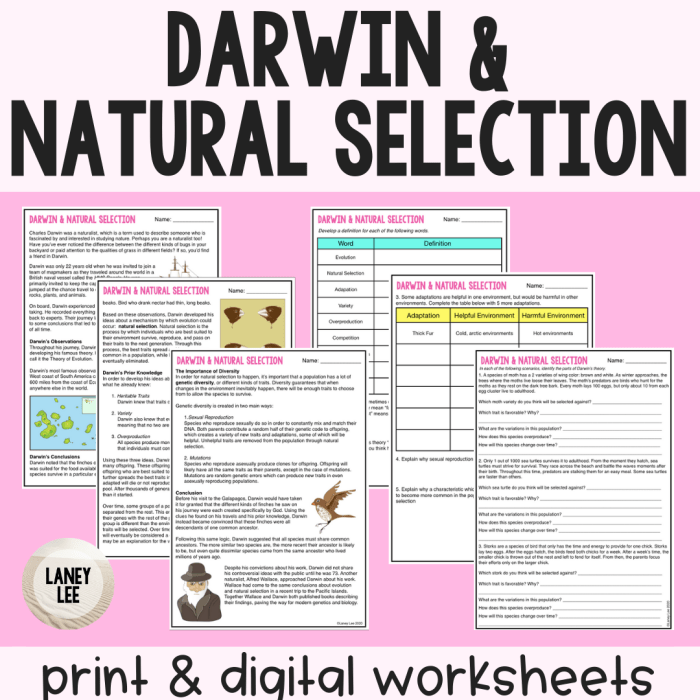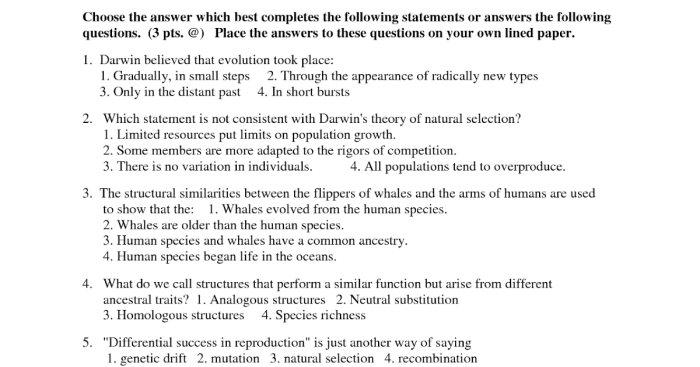Study guide evolution and natural selection answer key – Embark on a captivating journey with our comprehensive study guide, “Evolution and Natural Selection: Answer Key.” Delve into the intricacies of this foundational scientific theory, exploring its significance, core concepts, and the compelling evidence that underpins it.
Prepare to unravel the mysteries of evolution, tracing its profound impact on life’s diversity and the human story. This guide will illuminate the mechanisms driving evolution, showcasing how natural selection shapes species and ecosystems. Join us as we navigate the challenges and ethical implications surrounding this transformative theory, empowering you with a deeper understanding of the natural world and our place within it.
1. Introduction
Studying evolution and natural selection is crucial for understanding the diversity and complexity of life on Earth. Evolution explains how species change over time, and natural selection provides the mechanism driving these changes. By understanding these concepts, we gain insights into the history of life, the interconnectedness of organisms, and the processes that shape our planet.
Evolution refers to the gradual change in the genetic composition of a population over generations. Natural selection, a key mechanism of evolution, occurs when individuals with traits that make them better suited to their environment have a higher chance of surviving and reproducing, passing on their advantageous traits to their offspring.
This process leads to the accumulation of favorable traits within a population over time, resulting in adaptation and the formation of new species.
2. Evidence for Evolution

Fossil Record, Study guide evolution and natural selection answer key
The fossil record provides compelling evidence for evolution. Fossils show a gradual progression of changes in organisms over millions of years. For example, the fossil record of horses reveals a series of transitional forms, from small, dog-sized ancestors to the modern horse.
Comparative Anatomy
Comparative anatomy compares the structures of different organisms to identify similarities and differences. These similarities suggest common ancestry and evolutionary relationships. For instance, the presence of homologous structures, such as the forelimbs of vertebrates, indicates a shared evolutionary history.
Molecular Biology
Molecular biology provides strong evidence for evolution through the analysis of DNA and protein sequences. By comparing genetic sequences between different species, scientists can infer evolutionary relationships and estimate the time since divergence from a common ancestor.
3. Mechanisms of Evolution

Natural Selection
Natural selection is the primary mechanism driving evolution. It acts on heritable variations within a population, favoring individuals with traits that enhance their survival and reproductive success in a given environment.
Genetic Variation
Genetic variation arises from mutations, genetic recombination, and gene flow. These processes introduce new alleles into a population, providing the raw material for natural selection to work on.
Genetic Drift
Genetic drift is the random change in allele frequencies within a population, particularly in small populations. It can lead to the loss of genetic diversity and the fixation of certain alleles, contributing to evolutionary change.
4. Natural Selection in Action

Examples of Natural Selection
Natural selection has been observed in various organisms, including antibiotic resistance in bacteria, beak size in Darwin’s finches, and camouflage in moths.
Formation of New Species
Natural selection can lead to the formation of new species through the process of speciation. Over time, populations can diverge genetically and become reproductively isolated, resulting in the emergence of distinct species.
Evolution of Humans
Natural selection has played a significant role in the evolution of humans. Adaptations such as bipedalism, tool use, and enhanced cognitive abilities have enabled our species to thrive in diverse environments.
5. Challenges to the Theory of Evolution
Misconceptions about Evolution
Common misconceptions about evolution include the belief that it is a linear progression, that it implies humans are descended from apes, and that it conflicts with religious beliefs.
Evidence Supporting Evolution
The overwhelming evidence from multiple scientific disciplines, including the fossil record, comparative anatomy, molecular biology, and genetics, supports the theory of evolution.
Ethical Implications of Evolution
Understanding evolution has ethical implications for issues such as genetic engineering, conservation, and the use of antibiotics. It raises questions about our responsibility to other species and the potential consequences of altering the genetic makeup of organisms.
Helpful Answers: Study Guide Evolution And Natural Selection Answer Key
What is the significance of studying evolution and natural selection?
Understanding evolution and natural selection provides insights into the mechanisms driving the diversity of life on Earth, the origin of species, and the interconnectedness of all living organisms.
How does natural selection contribute to evolution?
Natural selection acts as the driving force behind evolution, favoring individuals with advantageous traits that enhance their survival and reproductive success, leading to gradual changes in populations over time.
What are some common misconceptions about evolution?
Misconceptions about evolution often arise from misunderstandings about the theory’s implications. Evolution does not imply that humans are descended from apes but rather that both humans and apes share a common ancestor.